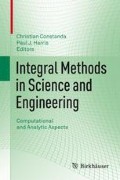Abstract
In this paper we study the spectral stability for a nonselfadjoint convection–diffusion operator on an unbounded 2-dimensional domain starting from a result about the pseudospectrum. Our goal is to study the spectrum of the following convection–diffusion operator A
defined on L 2(Ω), where Ω is an unbounded open set of ℝ2 and under a Dirichlet boundary condition. Our study is based upon pseudospectral theory because its tools are easier to handle and give better results when compared to those of spectral theory (see (Boulton 1999), (Reddy and Trefethen 1994), (Trefethen 1992), and (Trefethen 1997)). In fact, it has been established that the spectrum of a sequence of differential operators may be unstable when going to the limit, unlike the pseudospectrum which is known to be stable (see (Davies 2000) and (Davies 1995)). For ϵ>0 the pseudospectrum sp ε (A) of A is the union of the spectrum of A and the set of all z∈ℂ such that ‖(zI−A)−1‖≥ϵ −1. Equivalently (Roch and Silbermann 1996),
If A is a normal operator, its pseudospectrum is equal to the ϵ-neighborhood of its spectrum. We also exploit the fact that the spectrum of an operator is separated into two sets: The point spectrum, spp(A) which is composed of all the eigenvalues of A and the essential spectrum, spess(A) which is composed of all λ∈ℂ such that the operator λI−A is injective but not surjective. We conclude by a result on the stability of the spectrum obtained through pseudospectral theory.
Access this chapter
Tax calculation will be finalised at checkout
Purchases are for personal use only
Preview
Unable to display preview. Download preview PDF.
References
Davies, E.B.: Pseudospectra of differential operators. J. Operator Theory, 43, 243–262 (2000).
Davies, E.B.: Spectral Theory and Differential Operators, Cambridge University Press (1995).
Kato, T.: Perturbation Theory of Linear Operators, Second edition, Springer-Verlag, Berlin, Heidelberg and New York (1980).
Boulton, L.: Non-self-adjoint harmonic oscillator, compact semigroups and pseudospectra. Preprint, King’s College London (1999).
Reddy, S.C., Trefethen, L.N.: Pseudospectra of the convection–diffusion operator. SIAM J. Appl. Math., 54, 1634–1649 (1994).
Roch, S., Silbermann, B.: C*-algebra techniques in numerical analysis. J. Operator Theory, 35, 241–280 (1996).
Trefethen, L.N.: Pseudospectra of Matrices, Longman Sci. Tech. Publ., Harlow, UK (1992).
Trefethen, L.N.: Pseudospectra of linear operators. SIAM Review, 39, 383–406 (1997).
Author information
Authors and Affiliations
Corresponding author
Editor information
Editors and Affiliations
Rights and permissions
Copyright information
© 2011 Springer Science+Business Media, LLC
About this chapter
Cite this chapter
Guebbaï, H., Largillier, A. (2011). Spectra and Pseudospectra of a Convection–Diffusion Operator. In: Constanda, C., Harris, P. (eds) Integral Methods in Science and Engineering. Birkhäuser Boston. https://doi.org/10.1007/978-0-8176-8238-5_16
Download citation
DOI: https://doi.org/10.1007/978-0-8176-8238-5_16
Publisher Name: Birkhäuser Boston
Print ISBN: 978-0-8176-8237-8
Online ISBN: 978-0-8176-8238-5
eBook Packages: Mathematics and StatisticsMathematics and Statistics (R0)

